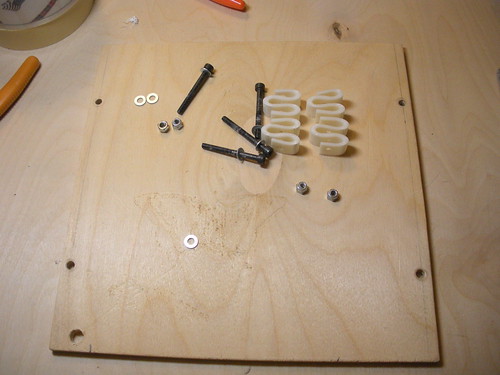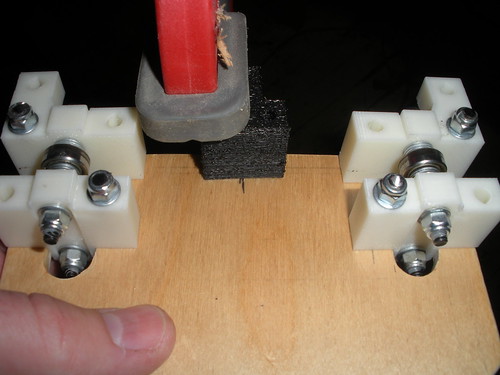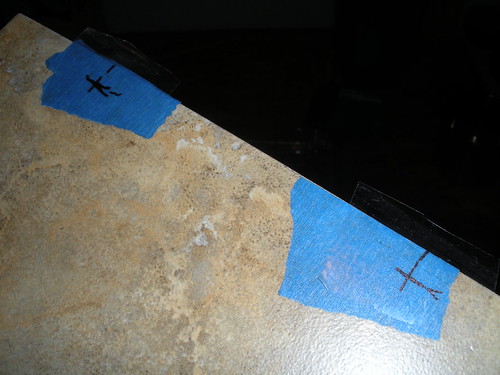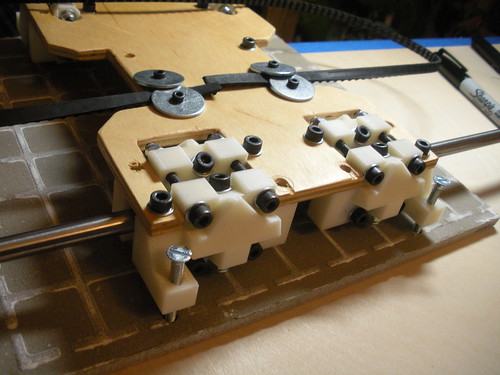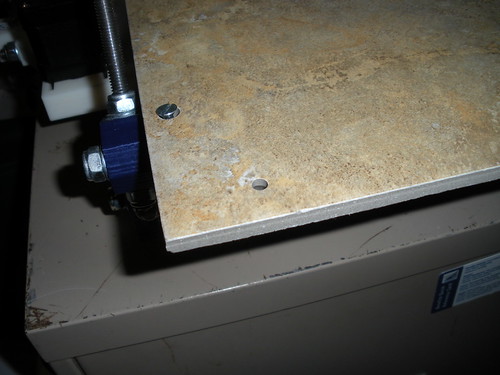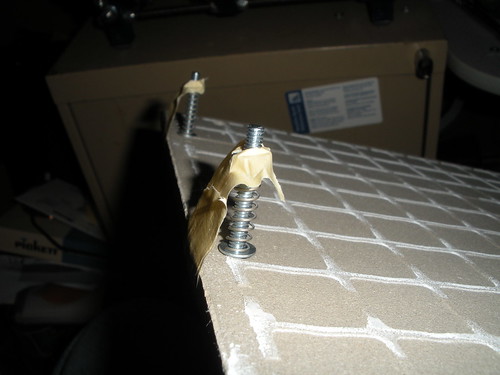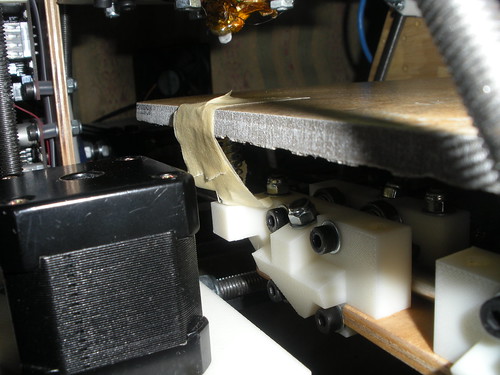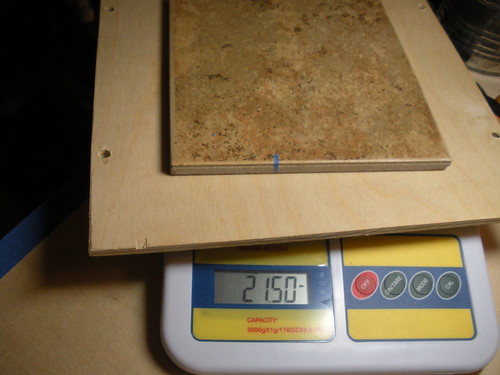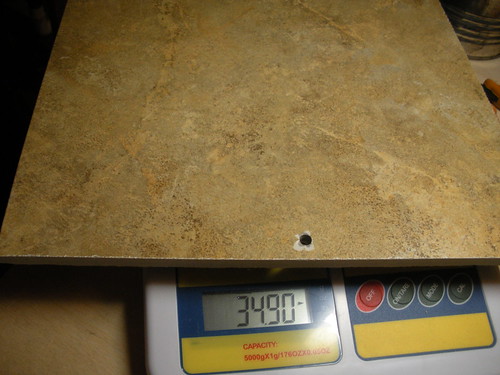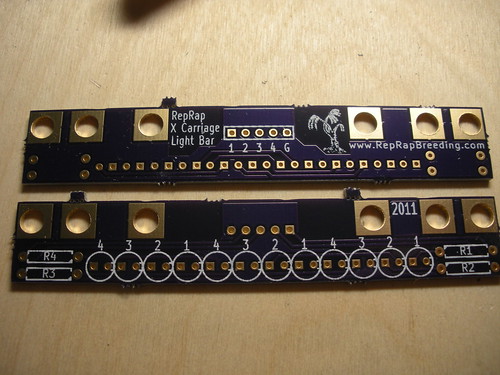I finally made time to pull off the old bed and drill the holes in the new tile. I always hate to mess with the printer unless it is broken, but I had waited long enough to find out how well the tile would work.
I had read some things about mounting the bed on only three points instead of four and thought that made sense. So I designed & printed a mount to attach to the froglet on the 180° side.
I then removed the bed and springs.
I decided that I could gain some height by cutting off the screws on the y carriage.
After blocking all the electronics I cut one screw off. I then decided that the amount of metal debris created was risky and removed the carriage to cut the remaining screws.
After cutting the screws off I drilled holes to mount the new support.
I then marked the first two hole on the tile and drilled them (under water).
I then used the first two holes to locate the third
This last hole had a small amount of chip out on the top surface since I drilled it from the back. Most of this was removed when I drilled the countersink.
I then temporarily mounted the tile so I could mark and then drill the purge hole (at 0,0)
Finally, with the assistance of some tape, I mounted the bed using new springs.
I gained almost 12mm of height:
I am printing on it right now and it is working beautifully and is overall a very good success.
My only concerns are that the springs I am using are not quite as stiff as think I would like and I added some weight (about 13oz from where I was).
Saturday, January 29, 2011
Saturday, January 22, 2011
New light bar PCBs
After making my last light bar I had a few people ask me about buying one. So I fixed the issues I had with my first iteration of the PCB and had 3 more made using DorkbotPDX's PCB service. These boards are much nicer than the one from BatchPCB and they came faster as well (it is also cheaper if you need 3 of each board).
I love the purple solder mask and the silkscreen detail it very nice. I plan to assemble one of them to check that the changes I made to the PCB work as expected. After that I will have a production run made and have kits available to purchase.
It should now fit on a standard Mendel carriage, Rhys-Jones multi-material carriage, and a Prusa carriage.
I love the purple solder mask and the silkscreen detail it very nice. I plan to assemble one of them to check that the changes I made to the PCB work as expected. After that I will have a production run made and have kits available to purchase.
Wednesday, January 12, 2011
A Ceramic Tile Print Bed
I was using a piece of polycarbonate that was to thin and was allowing parts to warp by lifting the PC sheet slightly. When thinking about stable, flat surfaces I realized ceramic tile could be a nice surface. So I went to my local home improvement store and bought a 6"x6" tile and tried it both plain and with blue tape on it. PLA did not stick to it alone but with the tape it works very well. It is very flat and stable, with the only downside I can see being that it is a little on the heavy side.

After proving to myself that it would work I thought about options for mounting a larger tile and tested drilling and countersinking holes in a scrap piece of tile I had.
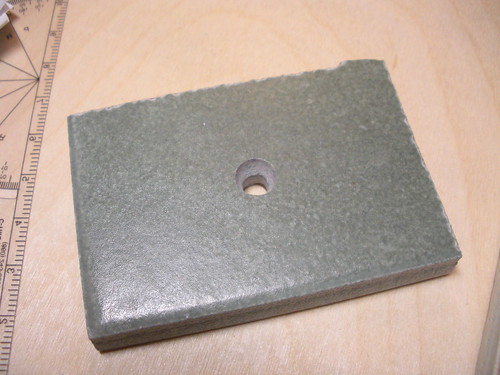
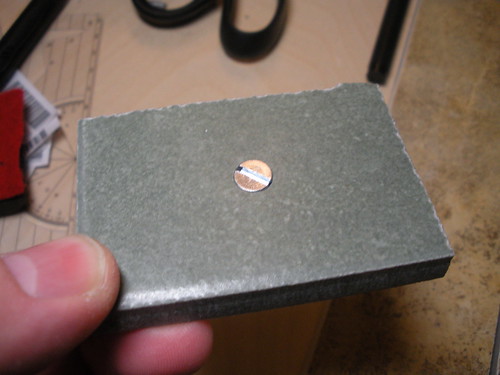
This also looks like it will work very nicely. My next step was to get a larger tile. The only problem here is that the Mendel print bed is not a standard tile size. However my local home improvement store will cut tile you buy there for free, at least small quantities, so I had them cut a 12" tile down to 9.5"x9.5" (which is a little bigger than the stock bed).
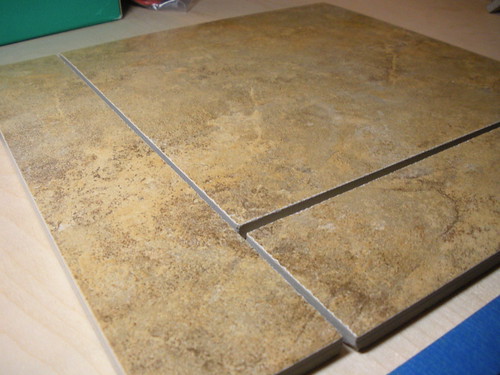
My next step is to drill the mounting holes, remove the wooden bed and mount my new tile bed. I am also thinking about adjusting the spring mount configuration to get a little more Z room and make the bed easily removable.
I may also do some testing with heating the tile as I think it would heat nicely as well.

After proving to myself that it would work I thought about options for mounting a larger tile and tested drilling and countersinking holes in a scrap piece of tile I had.


This also looks like it will work very nicely. My next step was to get a larger tile. The only problem here is that the Mendel print bed is not a standard tile size. However my local home improvement store will cut tile you buy there for free, at least small quantities, so I had them cut a 12" tile down to 9.5"x9.5" (which is a little bigger than the stock bed).

My next step is to drill the mounting holes, remove the wooden bed and mount my new tile bed. I am also thinking about adjusting the spring mount configuration to get a little more Z room and make the bed easily removable.
I may also do some testing with heating the tile as I think it would heat nicely as well.
Subscribe to:
Posts (Atom)

